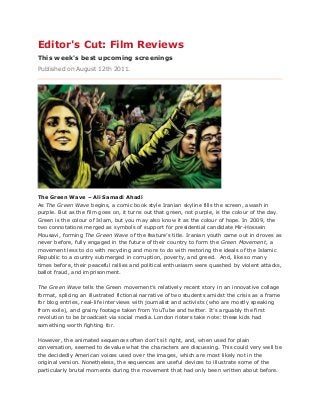
The Green Wave
- 1. Editor's Cut: Film Reviews This week's best upcoming screenings Published on August 12th 2011. The Green Wave – Ali Samadi Ahadi As The Green Wave begins, a comic book style Iranian skyline fills the screen, awash in purple. But as the film goes on, it turns out that green, not purple, is the colour of the day. Green is the colour of Islam, but you may also know it as the colour of hope. In 2009, the two connotations merged as symbols of support for presidential candidate Mir-Hossein Mousavi, forming The Green Wave of the feature’s title. Iranian youth came out in droves as never before, fully engaged in the future of their country to form the Green Movement, a movement less to do with recycling and more to do with restoring the ideals of the Islamic Republic to a country submerged in corruption, poverty, and greed. And, like so many times before, their peaceful rallies and political enthusiasm were quashed by violent attacks, ballot fraud, and imprisonment. The Green Wave tells the Green movement’s relatively recent story in an innovative collage format, splicing an illustrated fictional narrative of two students amidst the crisis as a frame for blog entries, real-life interviews with journalist and activists (who are mostly speaking from exile), and grainy footage taken from YouTube and twitter. It’s arguably the first revolution to be broadcast via social media. London rioters take note: these kids had something worth fighting for. However, the animated sequences often don't sit right, and, when used for plain conversation, seemed to devalue what the characters are discussing. This could very well be the decidedly American voices used over the images, which are most likely not in the original version. Nonetheless, the sequences are useful devices to illustrate some of the particularly brutal moments during the movement that had only been written about before.
- 2. The blood filling the screen from an animated figure is not so much a desensitizing tool in this film as a poetic rendering of something someone outside of the Iranian borders could barely comprehend. Juxtaposed with the tearful (live-action) remembrances of those who were there, as well as footage of protests and shows of brute force from the military, they turn out to be some of the most poignant moments in the eighty-minute documentary. Like any good documentary, The Green Wave evokes sympathy and outrage all at once: how could this happen? What is happening in Iran right now? What can I do? What did my government do for them? We’ve seen and read about coups and corruption and violence before, but this is right now, in our lifetimes. Of course, the minute the documentary is made it’s out of date: there is more to add, because it’s the document of a living history. Still, the fact that the story is told, giving voice to people who were silenced in those summer months of 2009, is a step forward and a chance to look at our social media as something more than just a frivolous time drain. All in all, The Green Wave is a raw and powerful look at a moment in time that has yet to be resolved. What it lacks in panache it makes up for in heart, and, like its subjects, it demands to be heard. As the economy plummets and people get increasingly tired of the status quo, The Green Wave is an excellent document of peaceful resistance, and a blueprint for social media’s potential capacity for good. Out September 30th